Evaluate Recommender System
1. The methodology for testing recommender systems offline.
1.1 train/test split

You measure your recommender system's ability to predict how people rated things in the past.
If you do this over enough people, you can end up with a meaningful number that tells you how good your recommender system is at recommending things, or more specifically, recommending things people already watched and rated. That's really all you can do, if you can't test things out in an online system.
1.2 k-fold cross-validation
If you really want to get fancy, it's possible to improve on a single train/test split by using a technique called k-fold cross validation.
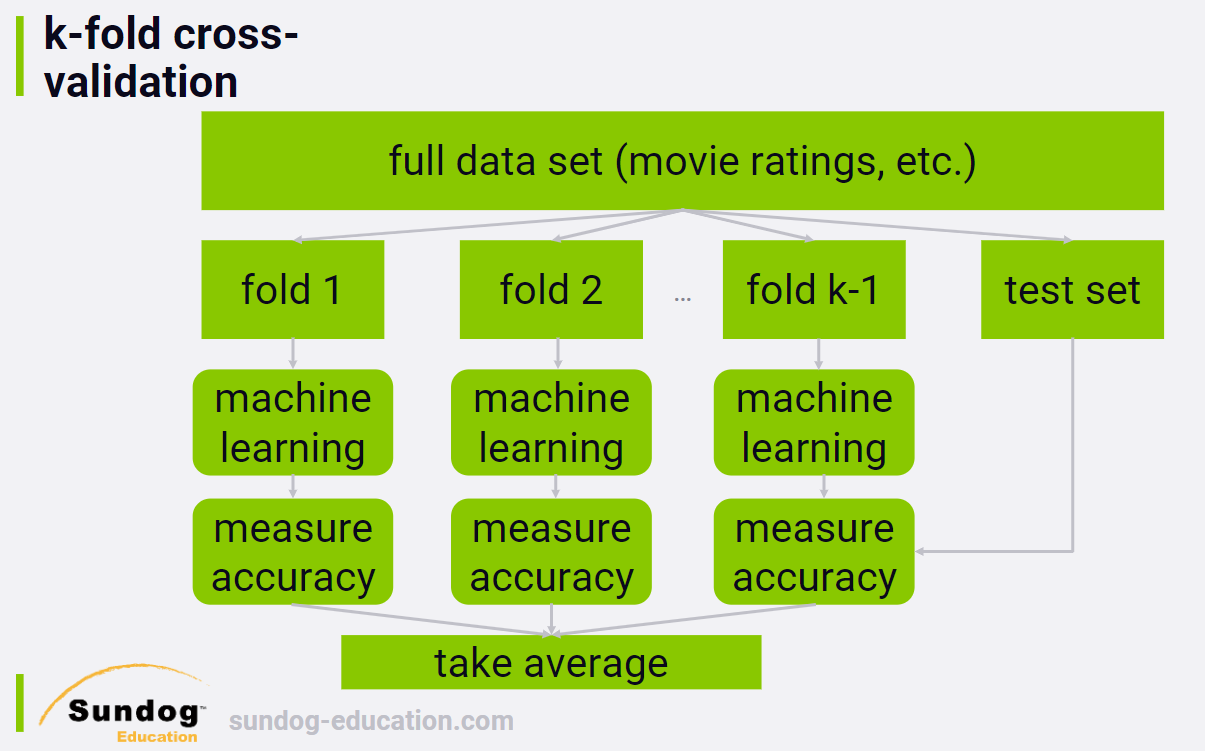
Instead of a single training set, we create many randomly assigned training sets. Each individual training set, or fold, is used to train your recommender system independently, and then we measure the accuracy of the resulting systems against your test set. So we end up with a score of how accurate each fold ends up predicting user ratings, and we can average them together.
This obviously takes a lot more computing power to do, but the advantage is that you don't end up over-fitting to a single training set.
注:By using train/test, all we can do is test our ability to predict how people rated movies they already saw. That's not the point of a recommender system. We want to recommend new things to people that they haven't seen, but find interesting. However, that's fundamentally impossible to test offline.
We haven't talked about how to actually come up with an accuracy metric when testing our recommender systems, so let's cover a couple of different ways to do it.
2. Accuracy Metrics (RMSE, MAE)
2.1 MAE
We want to minimize MAE.
2.2 RMSE
We want to minimize RMSE.
This is a more popular metric for a few reasons, but one is that it penalizes you more when your rating prediction is way off, and penalizes you less when your are reasonably close.
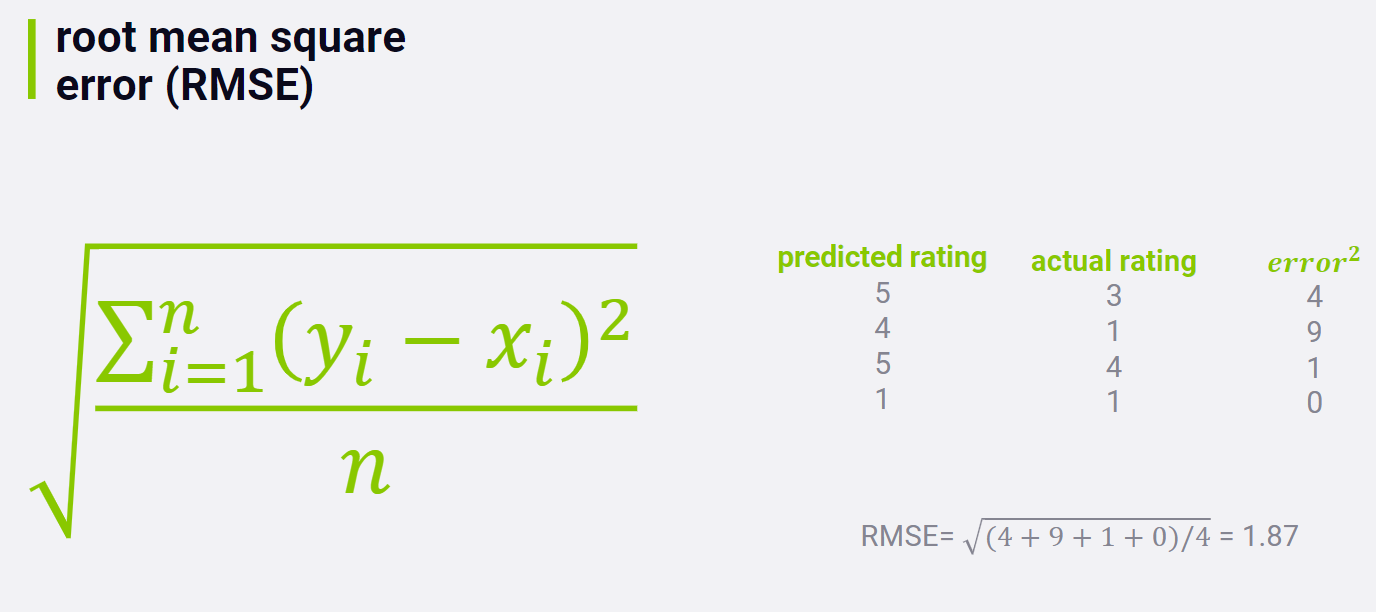
注:就推荐系统而言,RMSE just doesn't matter much in the real world. 人们并不关心你的系统对他们已经看过的电影的评分预测是否准确。What does matter is which movie you put in front of users in a top-N recommender list, and how those users react to those movies when they see them recommended.
3. Top-N Hit Rate - Many Ways
Different ways to measure the effectivenss of top-n recommenders offline:
3.1 Hit Rate
You generate top-n recommendations for all of the users in your test set. If one of the recommendations in a user's top-n recommendations is something they actually rated, you consider that a hit. You actually managed to show the user something that they found interesting enough to watch on their own already, so we consider that a success.
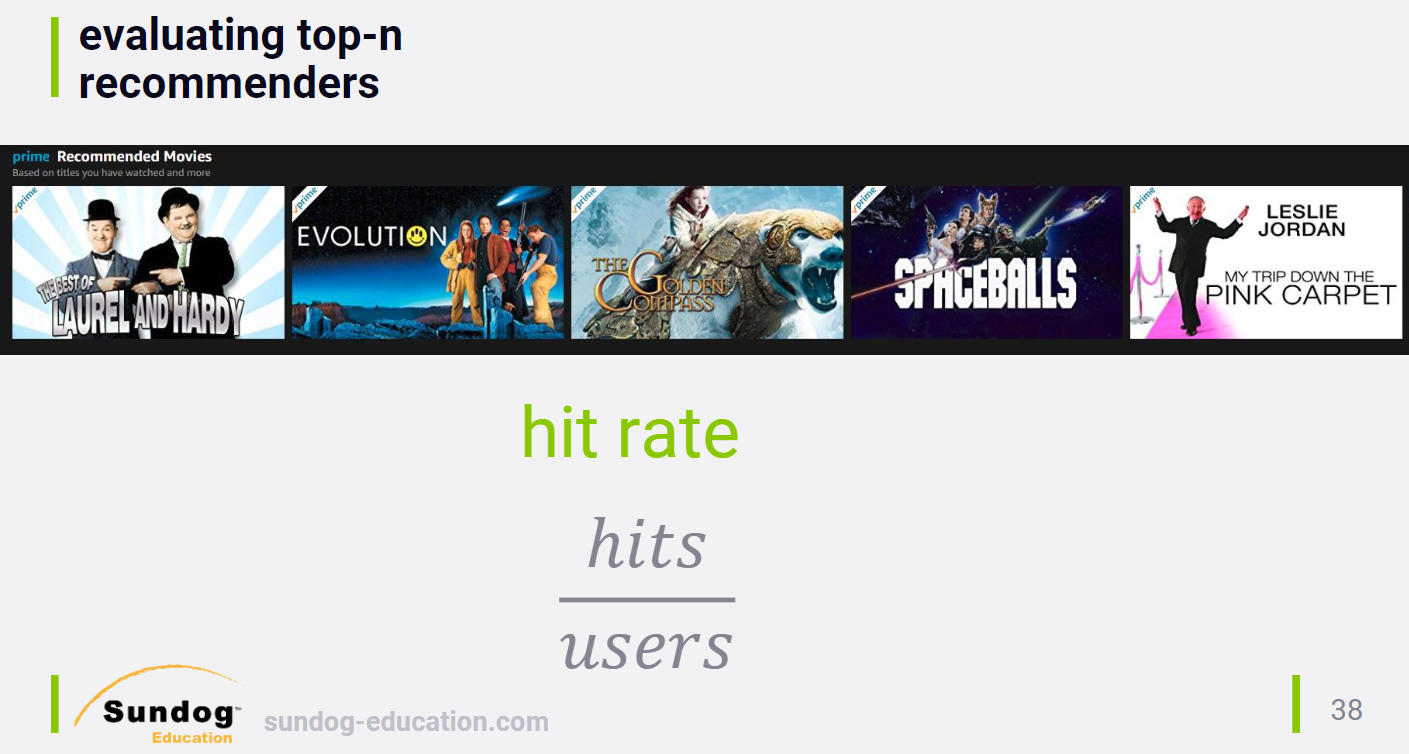
How to measure hit rate? Use leave-one-out cross validation.
3.2 leave-one-out cross validation
What we do is compute the top-n recommendations for each user in our training data, and intentionally remove one of those items from that user's training data. We then test our recommender system's ability to recommend that item that was left out in the top-n results it creates for that user in the testing phase.

The trouble is that it's a lot harder to get one specific movie right while testing than to just get one of the n recommendations. So "hit rate" with "leave-one-out" tends to be very small and difficult to measure, unless you have a very large data set to work with. But it's a much more user focused metric when you know your recommender system will be producing top-n lists in the real world, which most of them do.
3.3 ARHR
This metric is just like "hit rate", but it accounts for where in the top-n list you hits appear. Instead of summing up the number of hits, we sum up the reciprocal ranking of each hit.
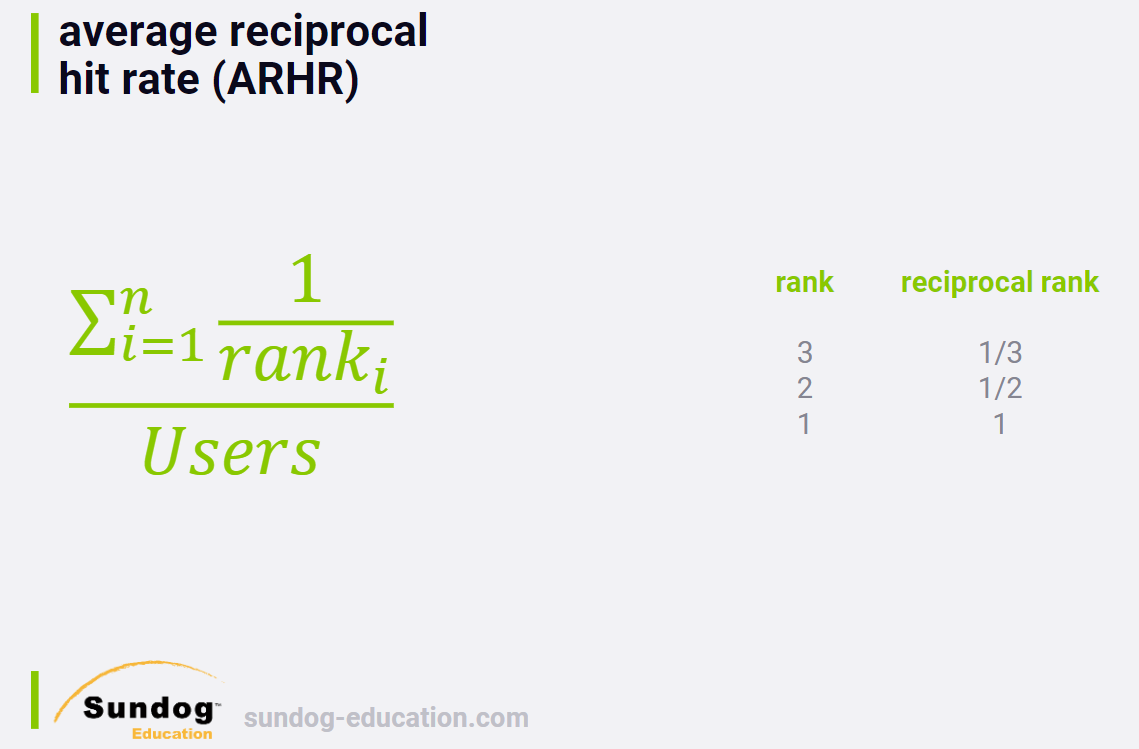
You end up getting more credit for successfully recommending an item in the top slot than in the bottom slot. Again, this is a more user focused metric, since users tend to focus on the beginning of lists.
3.4 cHR
Throw away hits if our predicted rating is below some threshold.
The idea is that we shouldn't get credit for recommending items to a user that we think they won't actually enjoy.
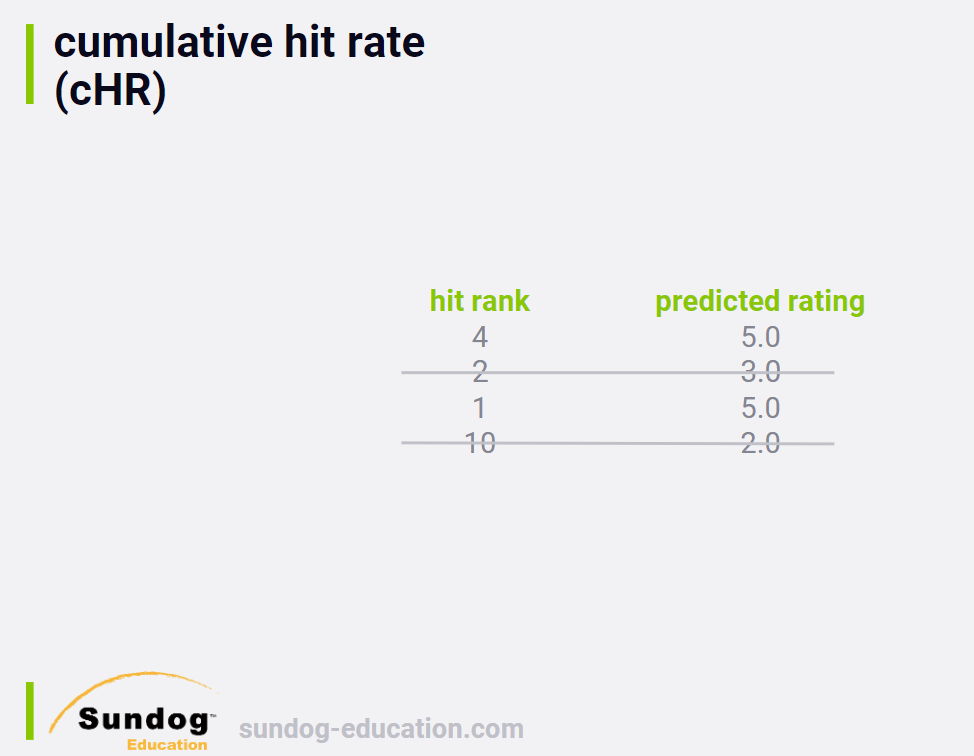
In this example, if we had a cutoff of three stars, we throw away the hits for the second and fourth items in these test results and our hit rate metric wouldn't count them at all.
3.5 rHR
Another way to look at hit rate is to break it down by predicted rating score.
It can be a good way to get an idea of the distribution of how good your algorithm thinks recommended movies are that actually get a hit. Ideally, you want to recommend movies that they actually like, and breaking down the distribution gives you some sense of how well you're doing in more detail.
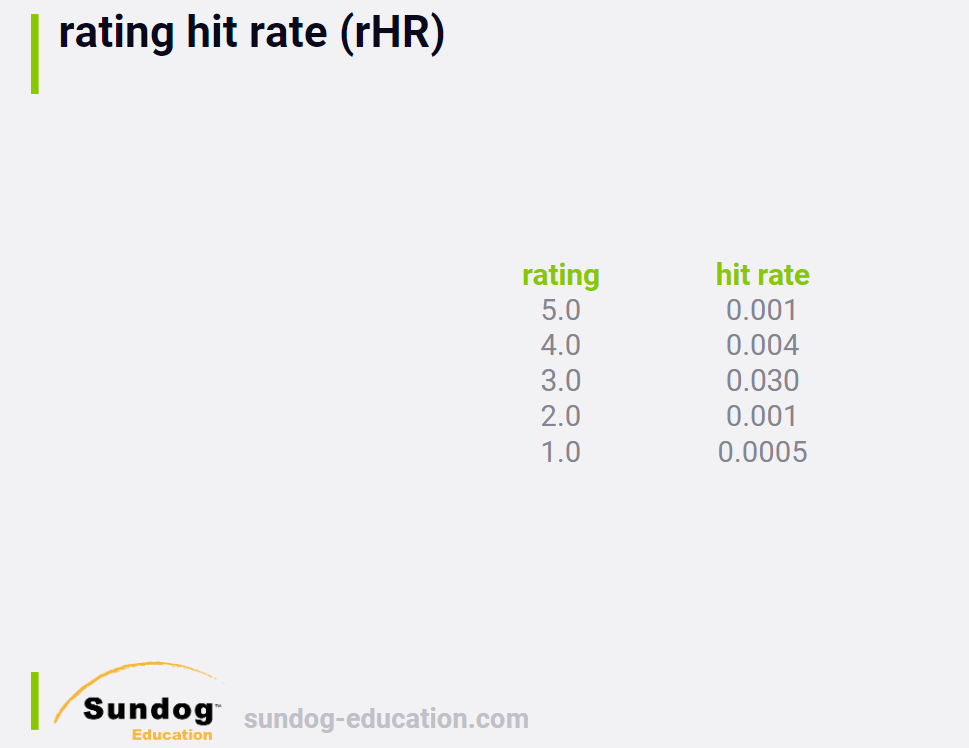
对每一个rating type (1,2,3,4,5), print out its hit rate.
4. Coverage, Diversity and Novelty
Accuracy isn't the only thing that matters.
4.1 Coverage 覆盖度
The percentage of possible recommendations that your system is able to provide.
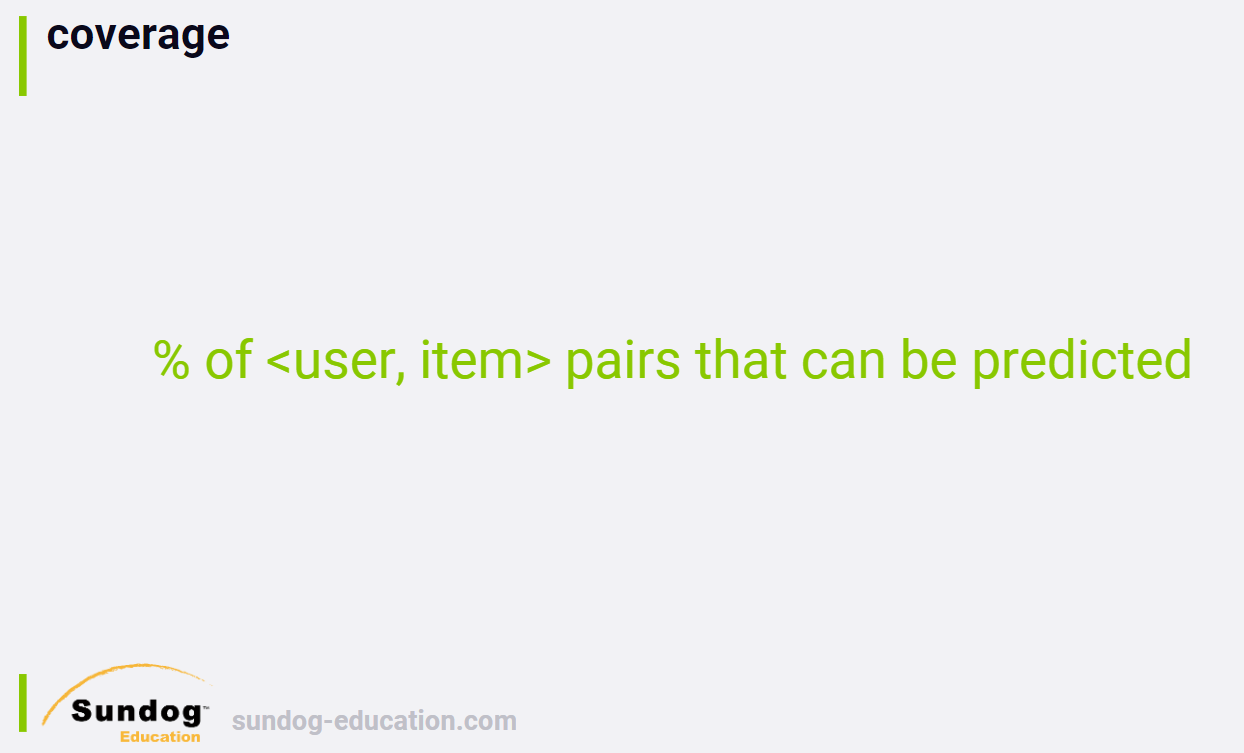
It's worth noting that coverage can be at odds with accuracy. If you enforce a higher quality threshold on the recommendations you make, then you might improve your accuracy at the expense of coverage. Finding the balance of where exactly you're better off recommending nothing at all can be delicate.
Coverage can also be important to watch, because it gives you a sense of how quickly new items in your catalog will start to appear in your recommendations. When a new book come out on Amazon, it won't appear in recommendations until at least a few people buy it, therefore establishing patterns with the purchase of other items. Until those patterns exist, that new book will reduce Amazon's coverage metric.
4.2 Diversity 多样性
You can think of this as measure of how broad a variety of items your recommender system is putting in front of people. An example of low diversity would be a recommender system that just recommends the next books in a series that you've started reading, but doesn't recommend book from different authors, or movies related to what you've read.
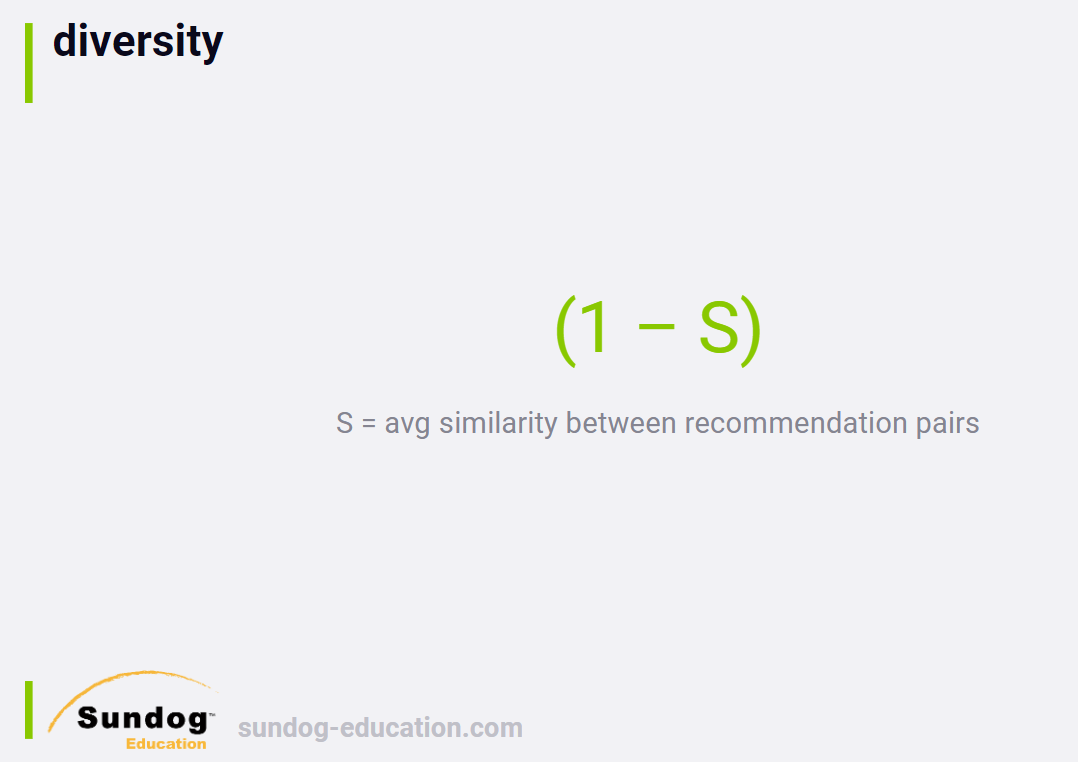
Diversity, at least in the context of recommender systems, isn't always a good thing. You can achieve very high diversity by just recommending completely random items. Unusually high diversity scores mean that you just have bad recommendations more often than not. You always need to look at diversity alongside metrics that measure the quality of the recommendations as well.
4.3 Novelty 新颖性
Similarly, novelty sounds like a good thing, but often it isn't. Novelty is a measure of how popular the items are that you are recommending. And again, just recommending random stuff would yield very high novelty scores, since the vast majority of items are not top sellers.
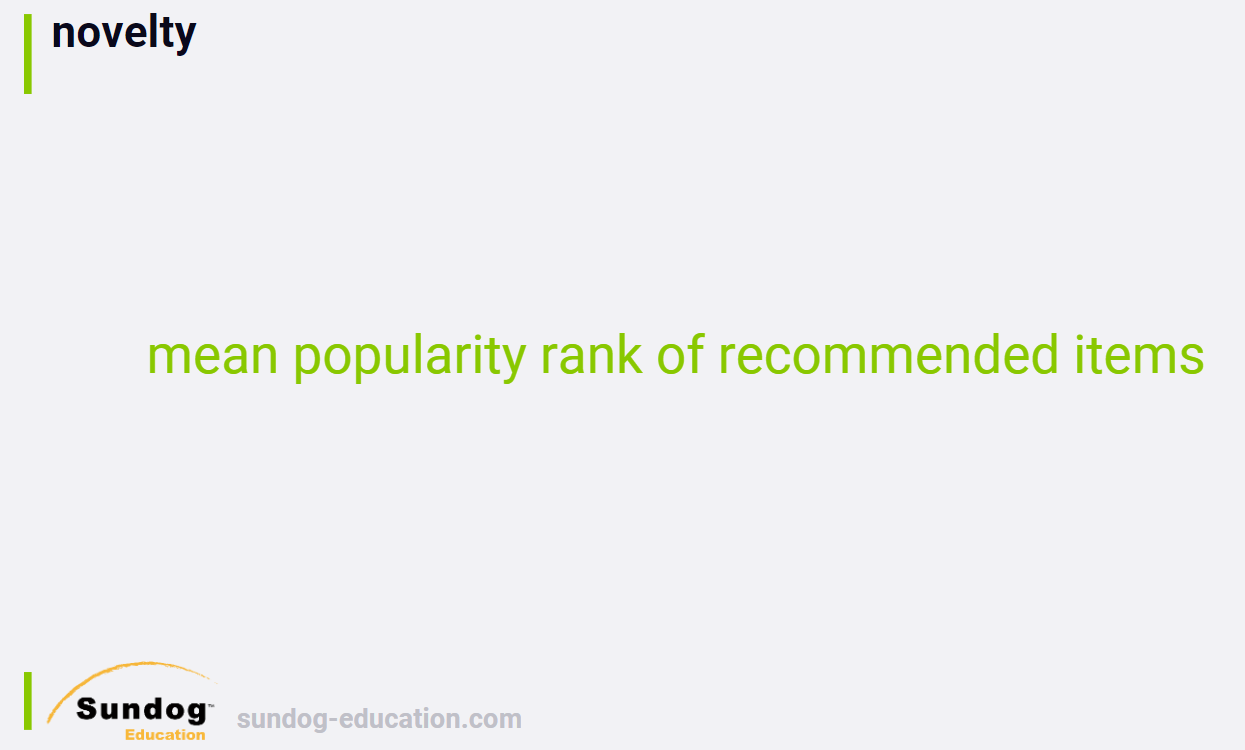
Although novelty is measurable, what to do with it is in many ways subjective. There's a concept of user trust in a recommender system. People want to see at least a few familiar items in their recommendations that make them say, "Yeah, that's a good recommendation for me. The system seems good". If you only recommend things people never heard of, they may conclude that your system doesn't really know them. Also, popular items are usually popular for a reason. They're enjoyable by a large segment of the population, so you would expect them to be good recommendations for a large segment of the population who hasn't read or watched them yet. If you're not recommending some popular items, you should probably question whether your recommender system is really working as it should.
You need to strike a balance between familiar, popular items and what we call serendipitous discovery of new items that user has never heard of before. (balance between novelty and trust). The familiar items establish trust with the user, and the new ones allow the user to discover entirely new things that they might love.
Novelty is important, because the whole point of recommender systems is to surface items in what we call "the long tail".
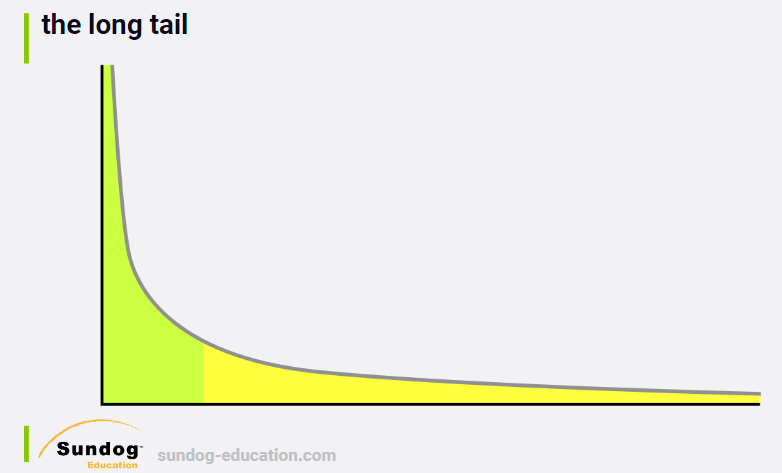
Imagine this is a plot of the sales of every item in you catalog, sorted by sales. Y 轴代表sales (popularity),X轴代表products. Most of sales来自于一小部分items,但是"long tail" makes up a large amount of sales as well. 黄色部分的item代表了人们各自感兴趣的东西. Recommender systems can help people discover those items in the long tail that are relevant to their own unique niche interests. If you can do that successfully, then the recommendations your system makes can help new authors get discovered, can help people explore their own passions, and make money for whoever you're building the system for as well. Everybody wins.
5. Churn, Responsiveness, and A/B Tests
5.1 Churn
Another thing we can measure is Churn.

Churn can measure how sensitive your recommender system is to new user behavior. 如果用户rate了一部新电影,会使得他的推荐内容发生很大的变化吗?If so, your churn score will be high. Maybe just showing the same recommendations too many times is a bad idea itself. 如果一个用户总是看到相同的推荐,但是不点击进去,在某个时候你应该停止推荐它而给用户推荐其他的东西。Sometimes, a little bit of randomization in your top-n recommendations can keep them looking fresh, and expose your users to more items.
But, just like diversity and novelty, high churn is not in itself a good thing. You could maximize your churn metric by just recommending items completely at random, 但显然这不是好的推荐。
All these metrics need to be looked at together, and you need to understand the trade-offs between them.
5.2 Responsiveness

If you rate a new movie, does it affect your recommendations immediately or next day after some nightly job runs? More responsiveness would always seem to be a good thing, but in the world of business, you have to decide how responsive your recommender really needs to be, since recommender systems that have instantaneous responsiveness are complex, difficult to maintain, and expensive to build. You need to strike your own balance between responsiveness and simplicity.
? What's important
前面讲了许多evaluate推荐系统的方法:MAE, RMSE, Hit rate in various forms, coverage, diversity, novelty, churn, and responsiveness.
So how do you know what to focus on? It depends.
It may even depend on cultural factors. Some cultures may want more diversity and novelty, while other cultures may want to stick to things that are familiar with them.
It also depends on what you're trying to achieve as a business. And usually, a business is just trying to make money, which leads to one more way to evaluate recommender systems that is arguably the most important of all: online A/B tests!
5.3 Online A/B Tests

参考:
https://github.com/NLP-LOVE/ML-NLP/tree/master/Project/17.%20Recommendation%20System
AB测试是一种很常用的在线评测算法的实验方法。它通过一定的规则将用户随机分成几组,并对不同组的用户采用不同的算法,然后通过统计不同组用户的各种不同的评测指标比较不同算法,比如可以统计不同组用户的点击率,通过点击率比较不同算法的性能。对AB测试感兴趣的读者可以浏览一下网站http://www.abtests.com/ ,该网站给出了很多通过实际AB测试提高网站用户满意度的例子,从中我们可以学习到如何进行合理的AB测试。
Doing online A/B tests to tune your recommender system using your real customers, and measuring how they react to your recommendations. You can put recommendations from different algorithms in front of different sets of users, and measure if they actually buy, watch, or otherwise indicate interest in the recommendations you've presented.
By always testing changes to your recommender system using controlled, online experiments, you can see if they actually cause people to discover and purchase more new things than they would have otherwise.
None of the metrics we've discussed matter more than how real customers react to the recommendations you produce in the real world. You can have the most accurate rating predictions in the world, but if customers can't find new items to buy or watch from your system, it will be worthless from a practical standpoint.
Online tests can help you to avoid introducing complexity that adds no value, and remember, complex systems are difficult to maintain.
SO REMEMBER, offline metrics such as accuracy, diversity, and novelty can all be indicators you can look at while developing recommender systems offline, but you should never declare victory until you've measured a real impact on real users from your work. User behavior is the ultimate test of your work.
Accurately predicted ratings don't necessarily make for good video recommendations. At the end of the day, the results of online A/B tests are the only evaluation that matters for your recommender system.
A/B 测试,常见的指标有点击率、用户停留时间、 广告收入等,需要注意分析统计显著性。同时,需要注意短期的指标和长期的指标相结合, 一些短期指标的提升有时候反而会导致长期指标下降 比如 ,经常推荐美女或者搞笑类的内容会带来短期的点击率提高,但是可能会引起长期的用户粘性下降。设计者需要从自己的产品角度出发,根据产品的需要制定评估指标,这样才能更好地指导推荐系统的优化方向。常见的评价指标如下:
Another thing you can do is just straight up ask your users, if they think specific recommendations are good.
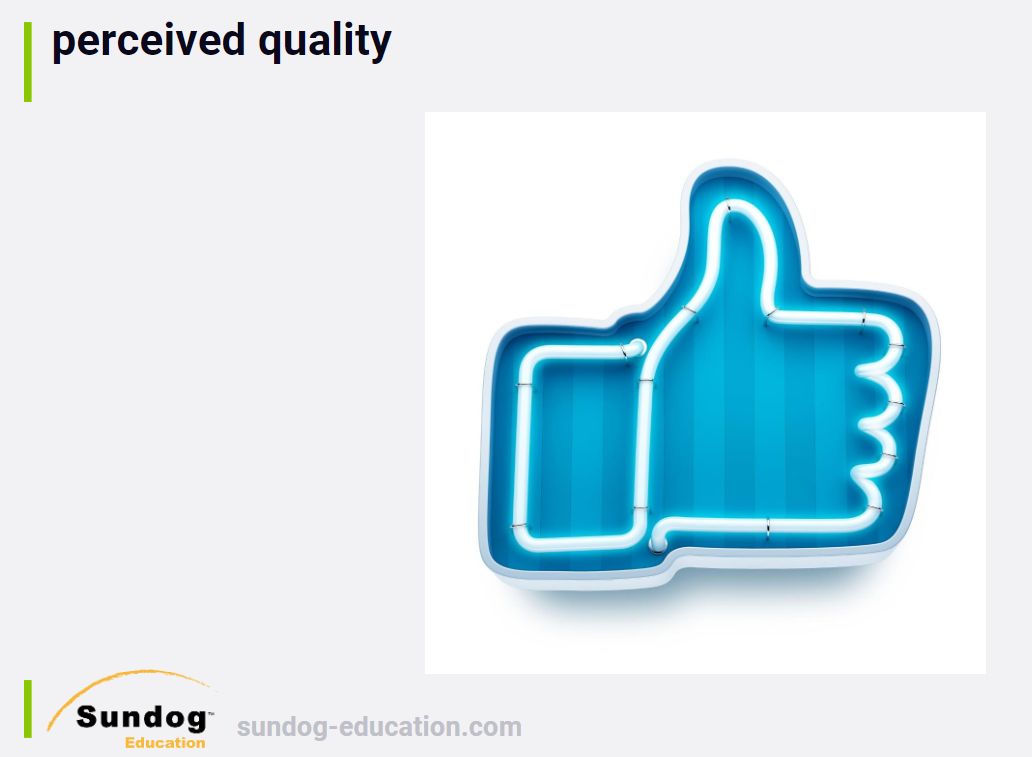
In practice though, it's a tough thing to do. Users will probably be confused over whether you're asking them to rate the item or rate the recommendation, so you won't really know how to interpret this data. It also requires extra work form your customers with no clear payoff for them, so you're unlikely to get enough ratings on your recommendations to be useful.
It's best to just stick with online A/B tests, and measure how your customers vote with their wallets on the quality of your recommendations.
Quiz

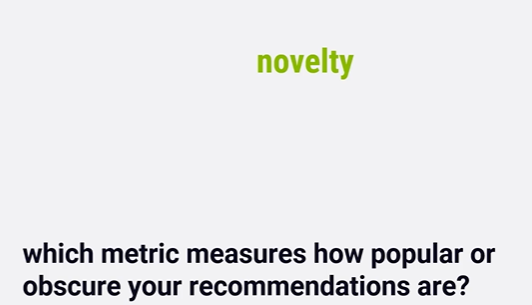

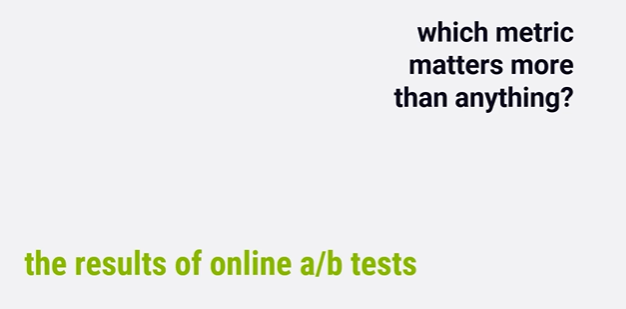
Code Walkthrough
使用Python中的library: Suprise. SupriseLib's documentation online
Suprise is built around measuring the accuracy of recommender systems. Although this is the wrong thing to focus on, it's really the best we can do without access to a real, large-scale website of our own.
Evaluating文件夹里的:

RecommenderMetrics中实现了前面讲到的用来evaluate recommender system的各种metrics.
TestMetrics中调用了RecommenderMetrics中的方法来实现一个real recommender system并evaluate it.
结果分析
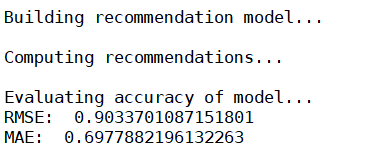
RMSE大概0.9,MAE大概0.7。
On average, our guess of rating for a given movie for a given user, was off by about 0.7 stars. RMSE is higher, meaning that we got penalized for being way off more often than we'd like.
Remember, error metrics are bad. 你想要RMSE与MAE越低越好,if accuracy is your goal.
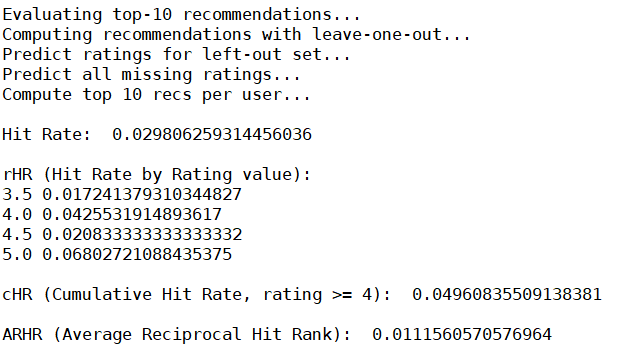
- Hit Rate大概 3%,which actually isn't that bad, considering that only one movie was left out from each user's rating to test with. 这个数值本身很难解释是好是坏,除非有其他的推荐系统可供比较。
- If we break it down by rating value, you can see that our hit rate did better at higher rating predictions, which make sense and it's what we want to see. Hit Rate在评分越高的类型中表现得更好(例如,在评分为5的电影中,Hit Rate为 6%)。
- Cumulative Hit Rate with a 4.0 threshold isn't much lower than the raw hit rate, meaning that we're doing a good job of recommending items we think are good recommendations.
- ARHR is 0.01. It takes the ranking of the hits into account. Again, it has no real value until we have other recommender systems to compare it against.
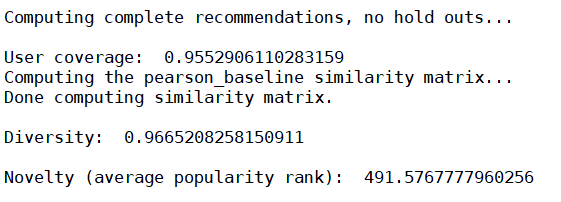
We look at user coverage for which we have at least one 4-star rating prediction, ant it's pretty high. That's good.
Diversity is really high at 0.96, and novelty seems pretty high, with an average popularity rank of 491. Remember there are only a few thousand movies in our data set to begin with.
This tells us that our algorithm is going pretty deep into the long tail to get its recommendations and that could be a problem in the real world. Novelty比较高(平均受欢迎程度排名比较靠后),说明推荐的都是比较小众的电影(long tail).
总结
So even though our accuracy metrics look okay here, diversity and novelty is telling us that we're recommending a lot of really obscure stuff. And that could be an issue when trying to establish user trust in the system. People generally want to see a few things that at least look familiar. So I would expect this particular algorithm wouldn't do that well in an online A/B test, but you can never really know until you actually try it.
Anyhow, we now have working code now for evaluating real recommender systems!